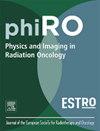The value of post radiotherapy prostate specific antigen dynamics for prostate cancer risk stratification models
IF 3.3
Q2 ONCOLOGY
引用次数: 0
Abstract
Background and purpose
Risk-stratification at diagnosis of prostate cancer does not always predict risk of biochemical recurrence (BCR). Fully utilizing post-radiotherapy follow-up Prostate Specific Antigen (PSA) data could offer earlier and higher prognostic value than pre-treatment risk-stratification.
We investigate whether PSA dynamics in the first three-years of follow-up can re-stratify risk of treatment failure after radical radiotherapy, allowing for targeted intervention.
Materials and methods
Retrospective analysis of repeat follow-up PSA measurements from men with mixed-risk prostate cancer treated in two separate radical radiotherapy techniques (n = 446, 2005–2007). PSA trajectories were modelled between zero and three-years follow-up using Gaussian Process regression. Models were sampled and clustered using hierarchical clustering to define characteristic post-radiotherapy PSA trajectories.
Kaplan-Meier analysis compared dichotomising by pre-treatment risk-group and characteristic PSA trajectory. Cox proportional-hazard models with and without follow-up PSA information compared using Akaike Information Criterion (AIC).
Results
PSA trajectories were characterized as stable, steady-rise, and unstable. Kaplan-Meier analysis showed that pre-treatment risk-group was not prognostic of BCR (p > 0.05), however characteristic PSA trajectory was (p < 0.001). PSA trajectory improved multivariable model performance when added to baseline prognostic variables. Unstable PSA had highest BCR.
Results were validated across two cohorts and sensitivity analysis, suggesting results were robust. However, analysis excluded patients with BCR within three-years follow-up due to lack of data.
Conclusion
PSA dynamics within the first three-years of post-radiotherapy follow-up for prostate cancer were more prognostic of BCR than pre-treatment risk-groups, suggesting PSA dynamics could be used to re-stratify BCR risk during early follow-up.
放疗后前列腺特异性抗原动态对前列腺癌危险分层模型的价值
背景与目的前列腺癌诊断时的风险分层并不总能预测生化复发(BCR)的风险。充分利用放疗后随访前列腺特异抗原(PSA)数据,比治疗前风险分层更早、更有预后价值。我们研究在前三年的随访中PSA动态是否可以重新划分根治性放疗后治疗失败的风险,从而允许有针对性的干预。材料和方法回顾性分析2005-2007年接受两种单独根治性放射治疗的混合风险前列腺癌患者的重复随访PSA测量(n = 446)。使用高斯过程回归对零至三年随访期间的PSA轨迹进行建模。使用分层聚类对模型进行采样和聚类,以定义放射治疗后PSA的特征轨迹。Kaplan-Meier分析比较了治疗前风险组和PSA特征轨迹的二分法。使用Akaike信息标准(AIC)比较有和没有随访PSA信息的Cox比例风险模型。结果spsa轨迹具有稳定、稳升和不稳定三种特征。Kaplan-Meier分析显示,治疗前风险组对BCR的预后无影响(p >;0.05),但典型PSA轨迹为(p <;0.001)。当加入基线预后变量时,PSA轨迹改善了多变量模型的性能。不稳定PSA的BCR最高。结果通过两个队列和敏感性分析进行验证,表明结果是稳健的。然而,由于缺乏数据,分析排除了随访3年以内的BCR患者。结论前列腺癌放疗后随访前3年PSA动态比治疗前风险组更能预测BCR的预后,提示PSA动态可用于早期随访时BCR风险的重新分层。
本文章由计算机程序翻译,如有差异,请以英文原文为准。
求助全文
约1分钟内获得全文
求助全文
来源期刊

Physics and Imaging in Radiation Oncology
Physics and Astronomy-Radiation
CiteScore
5.30
自引率
18.90%
发文量
93
审稿时长
6 weeks
 求助内容:
求助内容: 应助结果提醒方式:
应助结果提醒方式:


